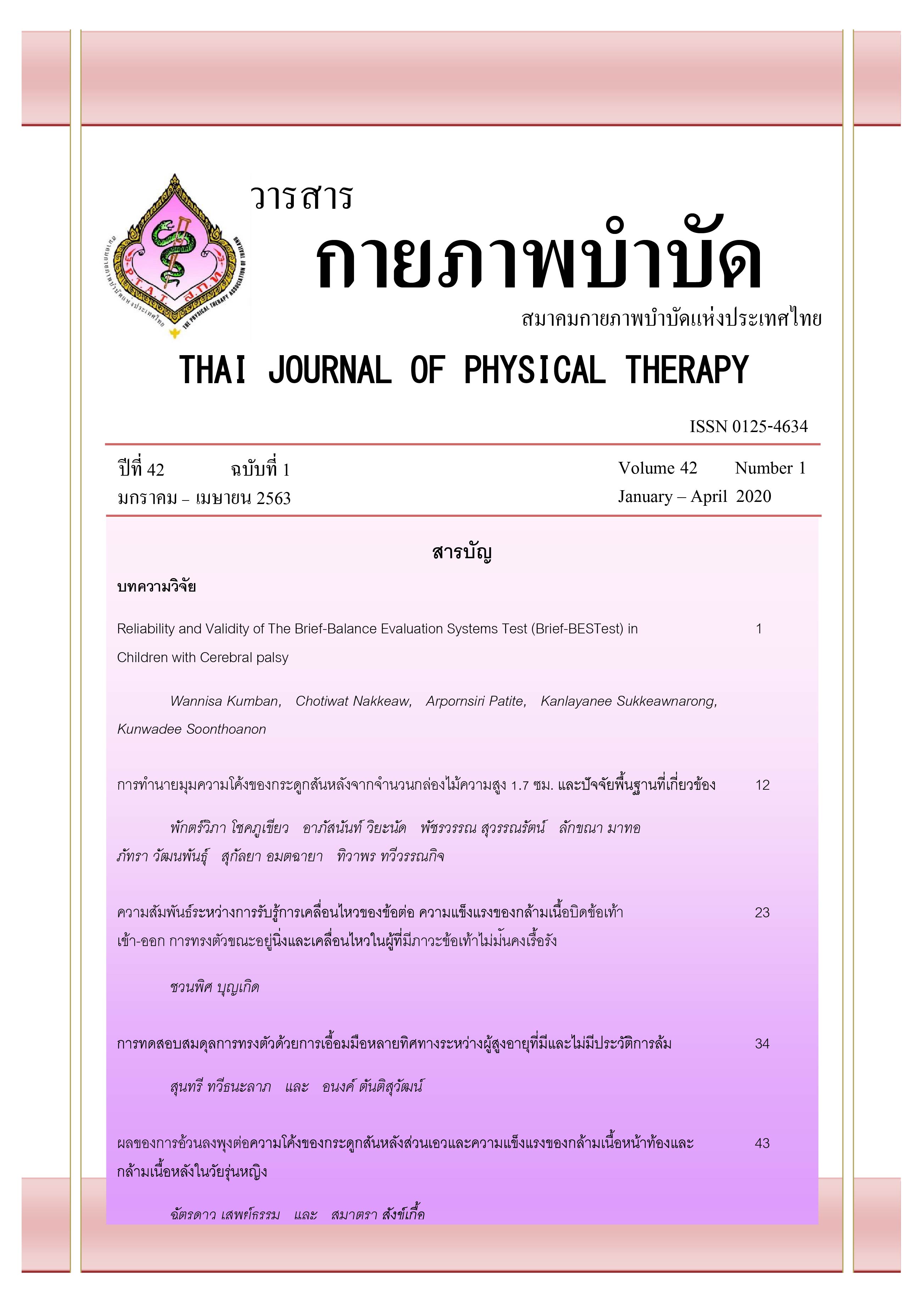ความเชื่อถือได้และความตรงของการใช้แบบประเมิน The Brief-Balance Evaluation Systems Test (Brief-BESTest) ในเด็กสมองพิการ
Main Article Content
บทคัดย่อ
ที่มาและความสำคัญ: เด็กสมองพิการมีปัญหาด้านการควบคุมการทรงตัวหรือการรักษาสมดุลของร่างกาย นับเป็นสาเหตุหนึ่งที่ส่งผลให้มีความยากลำบากในการเคลื่อนไหวหรือการทำกิจวัตรประจำวัน
วัตถุประสงค์: เพื่อศึกษาความเชื่อถือได้และความตรงของการใช้แบบประเมินการทรงตัว Brief-Balance Evaluation Systems Test (Brief-BESTest) และการเคลื่อนไหวของกล้ามเนื้อมัดใหญ่ในเด็กสมองพิการ
วิธีการวิจัย: รูปแบบของการศึกษานี้เป็นการพรรณนาแบบภาคตัดขวาง มีการสุ่มตามความสะดวกจากศูนย์การศึกษาพิเศษในเขตภาคใต้ในการคัดอาสาสมัครเข้าร่วมงานวิจัย โดยเป็นเด็กสมองพิการที่มีระดับความสามารถในการเคลื่อนไหวจำแนกด้วยระบบ GMFCS-E&R I-III อายุ 5-15 ปี อาสาสมัครได้รับการประเมินการทรงตัวด้วย Brief-BESTest และ Pediatric Balance Scale (PBS) และประเมินการเคลื่อนไหวของกล้ามเนื้อมัดใหญ่ด้วย Gross Motor Function Measurement (GMFM-88: Dimension D&E) ผู้วิจัยบันทึกวิดีโอเทปในการประเมินครั้งแรกและประเมินซ้ำจากภาพวิดีทัศน์หลังจากครั้งแรก 2 สัปดาห์ เพื่อวิเคราะห์ความเชื่อถือได้ภายในและระหว่างบุคคล โดยมีผู้ประเมินทั้งหมด 4 คน สำหรับการหาค่าความตรง (Concurrent และ Convergent validity) ใช้สถิติ Spearman Correlation (ρ) วิเคราะห์ความสัมพันธ์ของการประเมินการทรงตัวระหว่าง Brief-BESTest กับ PBS และระหว่างการประเมินการทรงตัวโดยใช้ Brief-BESTest กับการประเมินการเคลื่อนไหวของกล้ามเนื้อมัดใหญ่โดยใช้ GMFM-88 (Dimension D&E)
ผลการวิจัย: เด็กสมองพิการจำนวน 16 คน อายุเฉลี่ย 7.69+0.69 ปี ที่เข้าร่วมงานวิจัยครั้งนี้ ค่าความเชื่อถือได้ของการใช้ Brief-BESTest อยู่ในระดับสูงทั้งภายในบุคคล (ICC3,1=0.99) และระหว่างบุคคล (ICC2,4=0.95) และ Brief-BESTest มีความสัมพันธ์อย่างมีนัยสำคัญทางสถิติกับ PBS (ρ=0.93, p-value<0.05) และ GMFM-88 (Dimension D & E) (ρ=0.86, p-value<0.05)
สรุปผล: Brief-BESTest มีความเชื่อถือได้และความตรง เหมาะสมสำหรับการประเมินการทรงตัวและสะท้อนถึงความสามารถในการเคลื่อนไหวของกล้ามเนื้อมัดใหญ่ในเด็กสมองพิการได้ อีกทั้งการประเมินด้วย Brief-BESTest สามารถทำได้ง่าย รวดเร็ว และยังสามารถจำแนกถึงองค์ประกอบของการทรงตัวได้
Article Details
เอกสารอ้างอิง
Ngamthanawat P, Chavasiri S. Epidemiology of Pediatric Patients at Department of Rehabilitation Medicine, Siriraj Hospital. J Thai Rehabil Med. 2016; 26(1): 31-8.
Insook S. Epidemiology of Cerebral Palsy Pediatric Patients in Sanprasitthiprasong Hospital Ubonratchatani. Mahasarakham hospital journal. 2016; 13(2): 78-86.
Keeratisiroj O, Thawinchai N, Buntragulpoontawee M, and Siritaratiwat W. Epidemiology of children with cerebral palsy in special school, Northern and Northeastern of Thailand. 2014: 1-8.
Rosenbaum P, Paneth N, Leviton A, Goldstein M, Bax M, Damiano D, Dan B, Jacobsson B. A report: the definition and classification of cerebral palsy April 2006. Dev Med Child Neurol Suppl. 2007; 109: 8-14.
Liao HF, Jeng SF, Lai JS. The relation between standing balance and walking function in children with spastic diplegic cerebral palsy. Dev Med Child Neurol. 1997; 39: 106-12.
Rose J, Wolff DR, Jones VK. Postural balance in children with cerebral palsy. Dev Med Child Neurol. 2002; 44: 58-63.
Russell DJ, Rosenbaum PL, Cadman DT, Gowland C, Hardy S, Jarvis S. The gross motor function measure a means to evaluate the effects of physical therapy. Dev Med Child Neurol. 1989; 31(3): 341-52.
Hensangvilai K, Angsupaisal M, Intachom R. Reliability in using the Modified Gross Motor Function Measurement-66 Thai version by Physical Therapy student. J Med Tech Phy Ther. 2009; 21(2): 169-85.
Kembhavi G, JoHanna D, Joyce ME, Joan L. Using the berg balance scale to distinguish balance ability in children with Cerebral palsy. Pediatr Phys Ther. 2002; 02: 114-28.
Zaino CA, Marchese VG, Westcott SL. Timed up and down stairs test: preliminary reliability and validity of a new measure of functional mobility. Pediatr Phys Ther. 2004; 04: 90-8.
Williams EN, Carroll SG, Reddihough DS, Phillips BA, Galea MP. Investigation of the timed 'up & go' test in children. Dev Med Child Neurol. 2005; 47(8): 518-24.
Kumban W, Amatachaya S, Emasithi A, Siritaratiwat W. Times sit to stand test in children with cerebral palsy: reliability and concurrent validity. NeuroRehabilitation. 2013; 32(1): 9-15.
Franjoine MR, Joan SG, Taylor MJ. Pediatric Balance Scale: A modified version of the Berg Balance Scale for the school-age child with mild to moderate motor impairment. Pediatr Phys Ther. 2003; 15(2): 114-28.
Gan SM, Tung LC, Tang YH, Wang CH. Psychometric properties of functional balance assessment in children with cerebral palsy. Neurorehabil Neural Repair. 2008; 22(6): 745-53.
Yi SK, Hwang JH, Kim SJ, Kwon JY. Validity of Pediatric Balance Scales in Children with Spastic Cerebral Palsy. Neuropediatrics. 2012; 43: 307–13.
Jin-Gang H, Ji-Hea W, Jooyeon K. Reliability of the Pediatric Balance Scale in the assessment of the children with cerebral palsy. J Phys Ther Sci. 2012; 24: 304-5.
Natália de AC, Luanda AC, Renata CF, Claudia SO. Correlation between pediatric balance scale and functional test in children with cerebral palsy. J Phys Ther Sci. 2014; 26: 849-53.
Parminder KP, Jesse VJ, Susan LK. Is the BESTest at its best? A suggested Brief version based on Interrater reliability, validity, internal consistency, and theoretical construct. Phys Ther. 2012; 92(9): 1197-207.
Meizhen H, Marco YC. Psychometric properties of brief-balance evaluation systems test (Brief-BESTest) in evaluating balance performance in individuals with chronic stroke. Brain Behav. 2017; 7: 1-10.
Ryan PD, Abigail LL, James TC, Leland ED, Terry DE. Comparative utility of the BESTest, mini-BESTest and Brief-BESTest for predicting falls in individuals with Parkinson disease: A cohort study. Phys Ther. 2013; 93(4): 542-50.
Dewar R, Claus AP, Tucker K, Ware R, Johnston LM. Reproducibility of the Balance Evaluation Systems Test (BESTest) and the Mini-BESTest in school-aged children. Gait Posture. 2017; 55: 68-74.
Hyoungwon L. Correlation between the selective control assessment of lower extremity and pediatric balance scale scores in children with spastic cerebral palsy. J Phy Ther Sci. 2015; 27: 3645–49.
Silvia LP, Kayo AF, Tatiana de OS, Nelci AC. Functional balance and gross motor function in children with cerebral palsy. Res Dev Disabil. 2014; 35: 2278–83.


